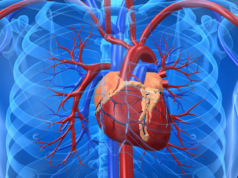
The European Association of Cardio-Thoracic Surgery (EACTS) has withdrawn its support of the left main recommendations of the society’s joint guidelines with the European Society of Cardiology (ESC) on myocardial revascularisation following an investigation into the EXCEL trial by the BBC current affairs programme Newsnight. The programme has cast doubt upon the conclusions drawn by EXCEL trial investigators (who have now responded to the claims; see latest comments).
A statement from Domenico Pagano, secretary general of EACTS, says: “The reported outcomes of the EXCEL trial were one of the major clinical trial results used to inform the joint 2018 EACTS-ESC Clinical Guidelines for Myocardial Revascularisation. We recognise that if the data and the analysis Newsnight has carried out are correct, as they appear to us to be, patients have been subjected to an increased risk of death. That is why the EACTS Council voted unanimously to withdraw our support for the guidelines on left main disease with immediate effect. We urge our members to disregard the guidelines relating to left main disease for the time being.” Pagano adds that he has written to the ESC to invite them to work with EACTS to develop a new joint section of the guidelines “as a matter of urgency”.
In an official response released to Cardiovascular News, the ESC says that it currently stands by the joint guidelines which, it states, were “based on the totality of peer-reviewed, published data available at the time”. It adds: “In the past few days, we have been informed that there may be additional findings from one study that had not been included in the original publication or shared with the ESC or its guidelines taskforce. We look forward to reviewing these data with our surgical colleagues, also in the context of further evidence published in 2019, and to assess their relevance to our current recommendations.” The society has also published this statement on its Twitter account
The three-year results of EXCEL were published in 2016; the study compared coronary artery bypass grafting (CABG) with percutaneous coronary intervention (PCI) in patients with left main disease and concluded that there was no significant difference in the primary endpoint of death, stroke, or myocardial infarction (MI) between the treatments.
Unpublished data
However, according to Newsnight, lead EXCEL researcher Gregg Stone (Icahn School of Medicine, Mount Sinai, New York, USA) and colleagues guaranteed that, in addition to the findings in the trial on periprocedural MI, they would also publish data for incidence of MI according to the universal definition. The programme claims that Stone et al failed to publish these data. Furthermore, reporter Deborah Cohen said, during the broadcast, that the unpublished data that used the universal definition to measure MI showed that “80% more patients with stents had heart attacks than those who had surgery”.
This finding, though, is disputed by Stone et al. They apparently told Cohen that Newsnight had been sent “fake data”. Neither Stone nor any other main EXCEL investigators were featured in video interviews in the programme. Ed Brown, who worked on the investigation, told Cardiovascular News via Twitter that “we did offer them the opportunity to talk to us on camera, but as you saw they didn’t”.
The programme also claims that the committee working on the EACTS-ESC guidelines for myocardial revascularisation had not seen the unpublished data. Nick Freemantle (director of the Comprehensive Clinical Trials Unit at University College London, London, UK), a member of the guidelines committee, asserts on Newsnight that had he been aware of the findings on universal MI, he would not have agreed to the current recommendation that PCI and surgery “are interchangeable treatments for low- and moderate-risk patients with left main disease”. He commented: “The EXCEL trial was absolutely crucial to the recommendations for this particular group of patients.” He added that, as a result of making the “wrong recommendation”, “patients who have received stents will have died who otherwise would have lived for longer, survived for longer, had they had open heart surgery”.
The ESC, the programme noted, has rejected the view that the guidelines have harmed patients. The society told Newsnight that, even had the data on universal MI been available, the overall assessment of the EXCEL trial would not have changed, and that other evidence was taken into account in developing the guidelines.
Newsnight also reported that it has seen “leaked emails” in which the data safety monitoring board (DSMB) for EXCEL raised concerns about the “number of people with stents who were dying” and suggested the information should be made public “as soon as possible” in light of the fact that the guidelines that were being drawn up. The programme stated that the main trial investigators “pushed back on their concerns” but added that the researchers told them that the DSMB “allowed the trial to continue unchanged”.
The five-year outcomes of EXCEL were presented earlier this year at the Transcatheter Cardiovascular Therapeutics meeting (TCT 2019; 25–29 September, San Francisco, USA) and simultaneously published in the New England Journal of Medicine (NEJM). They showed that PCI with a second-generation drug-eluting stent in selected patients (low or intermediate anatomical complexity) with left main disease was non-inferior to CABG in terms of the primary endpoint of death, stroke, or myocardial infarction at five years. A week later, cardiothoracic surgeon David Taggart (University of Oxford, John Radcliffe Hospital, Oxford, UK) told delegates at the European Association for Cardio-Thoracic Surgery meeting (EACTS 2019; 3–5 October, Lisbon, Portugal) that the definition of MI in EXCEL was incorrect, leading to the wrong conclusion that PCI is non-inferior to CABG at five years for the management of selected patients with left main disease. He was an EXCEL trial investigator but said that he withdrew his name as an author because of his view on the conclusion. According to Taggart, the definition of MI was changed halfway through the trial—from 30 days’ post-procedure to a biochemical periprocedural one. Stone has refuted the claim.
Taggart appeared in a video interview on the Newsnight programme, discussing his “misgivings” about the findings on mortality observed at five years following PCI. He commented that these were higher than those found following bypass surgery, describing it as an “extremely alarming signal”. Stone has previously told Cardiovascular News: “There was no significant difference in cardiovascular mortality, which is what would be expected between two cardiac procedures if one was to improve survival”, and the finding was “much more likely” to be a play of chance.
Newsnight reviewed Taggart’s mortality concerns and also commented that the NEJM had requested the mortality finding be highlighted in the concluding paragraph. Although the EXCEL paper was later published without its inclusion, according to Newsnight, NEJM said “it had met their standards”.
Latest comments
12 December 2019
Response of EXCEL leadership
On behalf of the EXCEL leadership, we hereby respond to the misleading narrative questioning the conduct of the EXCEL trial that has been reported by certain members of the cardiovascular surgical community and a recent BBC Newsnight programme. This narrative was then promulgated by EACTS by withdrawing from guidelines without so much as even asking the EXCEL study group for clarification. The following are relevant facts about the conduct of the EXCEL Study:
Summary
Choice of the procedural myocardial infarction definition
It was agreed by all involved (including surgical colleagues) that the universal definition (UD) was not suitable because of ascertainment bias, different criteria for percutaneous coronary intervention (PCI) and coronary bypass grafting (CABG) and lack of demonstrated correlation with prognosis. The protocol definition of procedural myocardial infarction (MI) that met these criteria was thus selected and agreed to by unanimous consent.
The protocol MI definition changed
This is absolutely incorrect—the principal definition of MI never changed throughout the course of the trial.
The rate of procedural MI according to universal definition has been deliberately withheld. Procedural MI according to universal definition was listed in the protocol as one of ~35 exploratory secondary endpoints. This definition is based on troponins, the collection of which was optional in EXCEL and was unfortunately infrequently performed. Thus, reporting procedural MI rates according to UD was not possible. An exploratory attempt was made to assess procedural UDMI rates using troponins in some patients and CK-MB measures in others. However, this is not scientifically sound given the different sensitivities of these assays. EXCEL has published data that the protocol definition of MI was strongly correlated with subsequent mortality within the trial, whereas smaller biomarker elevations (as included in the universal definition criteria) would not have been prognostic. And until these recent events there had been no requests from any source to prioritise reporting procedural MI according to universal definition. Thus, there was absolutely no attempt to withhold meaningful data. Nonetheless, EXCEL commits to publish a future manuscript reporting the rates and implications of MI according to numerous definitions, including the universal definition using CK-MB data.
The all-cause mortality data from EXCEL was not strongly enough emphasised
All-cause mortality was a secondary underpowered endpoint and the modest difference noted between groups was not adjusted for multiplicity and is therefore statistically uncertain. In addition, it has no biological basis given that the clinical events committee adjudicated the excess to be principally due to sepsis and cancer occurring years after randomisation. Meta-analyses of 4,394 patients from four trials of drug-eluting stents vs. CABG (including EXCEL) show there is no difference in five-year mortality between PCI and surgery for left main disease. Even longer-term data (10-year follow-up from the SYNTAX trials) shows no difference in mortality. The distinction between all-cause mortality and cardiovascular mortality (which was very similar between PCI and CABG in EXCEL) was unfortunately not mentioned in the broadcast.
The DSMC raised concerns that were not adhered to
The independent Data Safety and Monitoring Committee met frequently to review unblinded EXCEL data, each time recommending that the study continue as planned without modification.
The ESC/EAPCI/EACTS Guidelines are unsafe
Guidelines are made on summated evidence from multiple trials and data input by independent experts in the field. The existing Guidelines which EXCEL helped to inform suggest stenting may be considered as a treatment for selected patients with left main stem coronary disease.
For full statement, click here.
11 December 2019
Statement from Adrian Banning, president of British Cardiovascular Intervention Society (BCIS) of BCIS on behalf of BCIS Council
On 9 December 2019, BBC Newsnight broadcast a 10-minute report about the Excel trial and its results. The Newsnight report raised concerns about the conduct and results of the trial, and in particular questioned whether stents can be safely recommended for the treatment of left main coronary artery disease.
Unfortunately, the limited time of the programme restricted explanation of the context of the Excel trial. This background information would facilitate informed discussion by patients and non-specialist cardiovascular physicians/surgeons. Regrettably, the BBC did not contact BCIS for comment and there was no informed counter discussion around the issues raised. The alarmist manner in which the trial was discussed has caused anxiety in patients with heart disease that have had stents and may cause confusion and concern for patients that are currently awaiting treatment with stents.
The concerns about various definitions of heart attack raised by the BBC will not change this principal finding which has been published in the New England Journal of Medicine. Although the trial was funded by a commercial stent company it was conducted by independent investigators and an independent trial organisation. It has already provided a wealth of information that has informed heart teams in their daily decision making.
Management of left main artery disease (the subgroup of patients studied in the Excel trial) is covered in the Guideline and a number of other trials were also considered including Syntax, Combat and Noble as well as Excel. After consideration of all of these trials, the Guidelines concluded that stents can be appropriately used to treat some patients with left main coronary artery disease. BCIS continues to endorse the existing ESC guideline and that some patients with left main disease should be considered for stents, whereas others are optimally treated with bypass surgery. This decision should be made by a multi-disciplinary heart team in conjunction with each individual patient.
Note: Banning was an investigator in the Syntax, Noble and Excel trials of left main disease. He was a member of the recent ESC/EACTS/EAPCI Guideline Committee. He has received reimbursement from stent manufacturers for speaking at educational events.
For full statement, click here
Society for Cardiovascular Angiography & Interventions
The Society for Cardiovascular Angiography & Interventions (SCAI) says it “respectfully” disagrees with EACTS about EXCEL. In a statement, it notes: “The authors of the EXCEL trial preferred the SCAI definition of MI [periprocedural MI] because it is based on the best available evidence linking biomarker abnormalities to subsequent mortality in large clinical trials, avoids ascertainment bias, and uses the same criteria for PCI and bypass surgery. The SCAI definition has been used in multiple clinical trials because it avoids the pitfall of tabulating MI events that are small enough to have little clinical impact. Instead, the SCAI definition permits assessment of MI events that are likely to be clinically relevant.”
Regarding Taggart’s concerns about mortality, the society comments: “While all-cause mortality is an important endpoint to follow, the EXCEL trial was neither designed nor powered to assess differences in this endpoint. Lethal differences in treatment effectiveness would be expected to manifest as differences in cardiovascular death rates; while this was also an unpowered observation, the lack of any difference in definite cardiovascular death at five years is reassuring. SCAI endorses the guidelines in Europe and the USA that support use of coronary stents for treatment of left main coronary artery disease in appropriately selected patients.”
For full statement click here.










